October 21, 2022
SEOUL – When world-weary city folk think of going on a vacation, Jeju is likely the kind of place they imagine.
Blue skies, palm trees and endless coastal roads that hug a crashing shoreline have earned the island its moniker, “The Hawaii of Asia”.
About 2½ times the size of Singapore and with a population of just 670,000, this South Korean island is made for self-drive holidays. The roads are clear, the drivers unhurried and, with the attractions spread out, you will cover more ground than if you stick to the laid-back bus system, which can mean wait times of up to an hour.
For nature lovers, there are meditative (if lung-busting) hiking trails. For foodies, an abundance of fresh seafood.
Children will enjoy themed parks such as Snoopy Garden as well as animal encounters – at Hueree Nature Life Park, visitors get to hand-feed Jeju’s iconic black pigs.
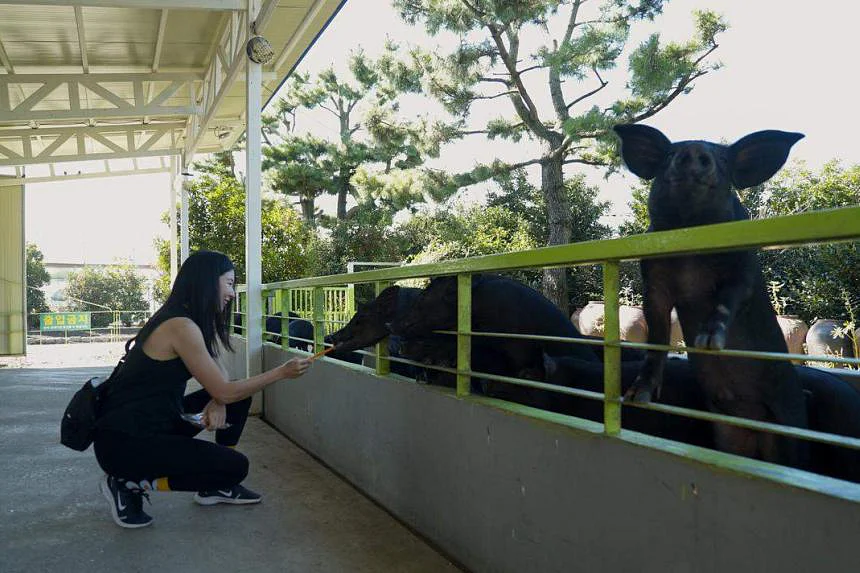
Hand-feed Jeju’s iconic black pigs at Hueree Nature Life Park. ST PHOTOS: AILEEN TEO
From the end of October, budget carrier Scoot will increase Singapore-Jeju flights to five times a week, after launching the thrice-weekly direct service in May. Budget flights to the country’s capital are cheap and plentiful, making it easy to tack on a Seoul leg to your trip.
Covering new attractions as well as classic experiences, here is a four-day Jeju road trip itinerary that takes in the island’s best sights.
Day one: Hit the road running
Scoot’s Singapore-Jeju flight lands in the morning, letting you pack in a full day of sightseeing once you touch down. Sleepy after the red-eye? A spot of go-karting will wake you right up.
Head to 9.81 Park Jeju (981park.com), where you can zip down three winding circuits on a gravity-powered kart at up to 40kmh. The futuristic park opened in 2020 and gives visitors the chance to feel like Formula One racers, with their timings captured on an app and leaderboard, and their race highlights edited into a snazzy video.
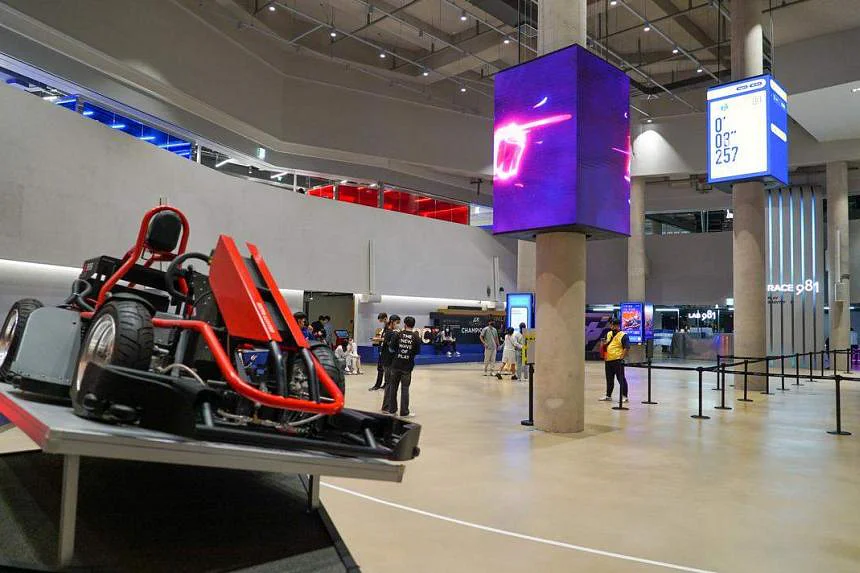
9.81 Park Jeju was opened in 2020 and gives visitors the chance to feel like Formula One racers. ST PHOTO: AILEEN TEO
In between rides, you can try the indoor sports lab, which offers arcade simulations of sports including skiing, curling and archery. It may not feel like the real thing, but there are bound to be lots of laughs. Plan for two to three hours here. Race and play packages start at 29,500 won (S$30).
Afterwards, do some actual driving down the coast towards Aewol Cafe Street. The stretch of cafes overlooks Jeju’s craggy coastline and many look like they have been designed for social media, with gorgeous photo spots backdropped by the ocean.

Cafes by the coast along Aewol Cafe Street. ST PHOTOS: AILEEN TEO
Cafe Knotted Jeju Aewol (@cafeknotted on Instagram), where I stop for coffee and doughnuts, has a whole garden decked out in fairy lights, palm trees and pastel decor that would not look out of place in a Taylor Swift music video.
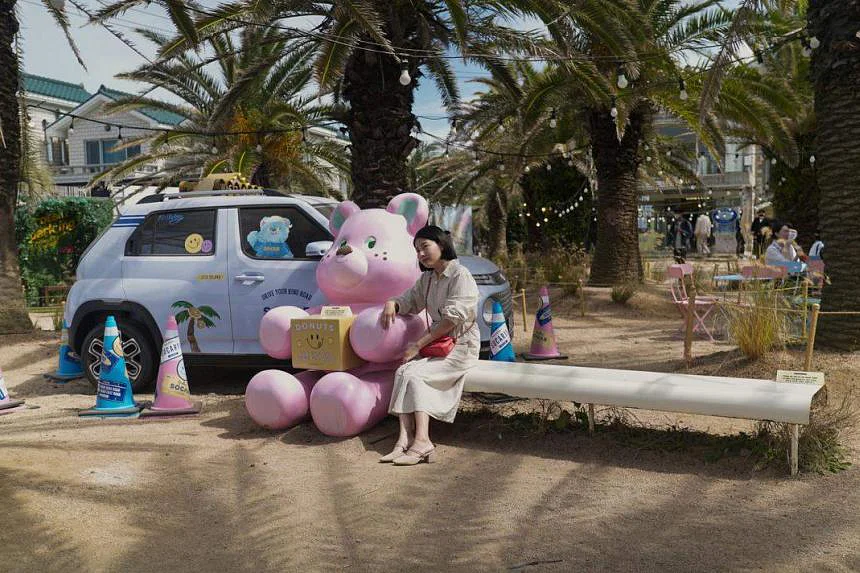
Cafe Knotted Jeju Aewol has a whole garden decked out in fairy lights, palm trees and pastel decor. ST PHOTO: AILEEN TEO
Make like the locals, take along a mobile phone tripod and do not be embarrassed about posing in public.
Jeju was formed through volcanic activity and you can see signs of this in the island’s lava caves, such as in Ssangyonggul Cave in Hallim Park (hallimpark.com; admission: 12,000 won). The cave was created by the volcanic eruption of Hallasan Mountain 2.5 million years ago and, today, visitors can meander through the cool, dark lava tubes.
The park has flowers in bloom all year round, with pink muhly grass in season during my visit in early October. There is also a bonsai garden, tropical greenhouse and a bird garden where you can hand-feed budgies in an aviary.

Hand-feeding birds in Hallim Park. ST PHOTOS: AILEEN TEO
Check in at Jeju Shinhwa World (shinhwaworld.com), an integrated resort that has multiple hotels, a mall, casino, water park and theme park.
The theme park is not quite Universal Studios – rides are more family-friendly than adrenaline-pumping, though I encounter a small roller coaster with 360-degree spinning seats.
Rooms at Jeju Shinhwa World Marriott Resort, where I stay, start at about $200. Make time for a quick soak in the outdoor pool, which is heated to a comfortable 28 to 30 deg C year-round and overlooks the water park.
Day two: Classic sights
Jeju is known for its green tea, which grows well in its mineral-rich, well-draining volcano soil.
Learn more about this at the Osulloc Tea Museum (str.sg/wVJ7) and surrounding tea gardens. Stop for brunch at the cafe, which sells all manner of green tea desserts including waffles, cakes and ice cream, or load up on boxes of tea for the folks back home.
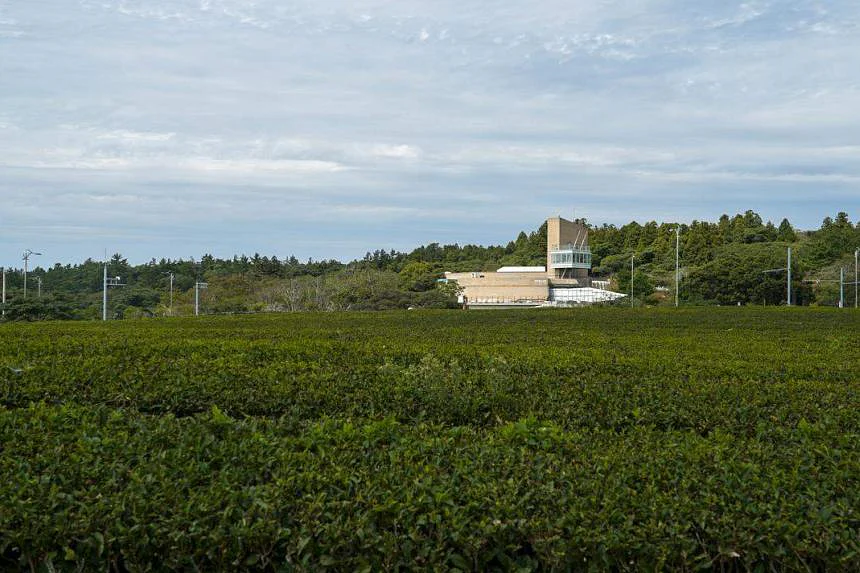
Tea plantation outside Osulloc Tea Museum. ST PHOTO: AILEEN TEO
Next door, pick up some skincare at Innisfree Jeju House (str.sg/wHCC). It is run by the same company – Amorepacific Corporation – that owns beauty brands such as Sulwhasoo, Laneige and Mamonde.
Store-exclusive products such as scarves and notebooks make good souvenirs, and a self-guided soap-making workshop is good fun. It costs 20,000 won to make two bars of soap, with a video tutorial as a guide.
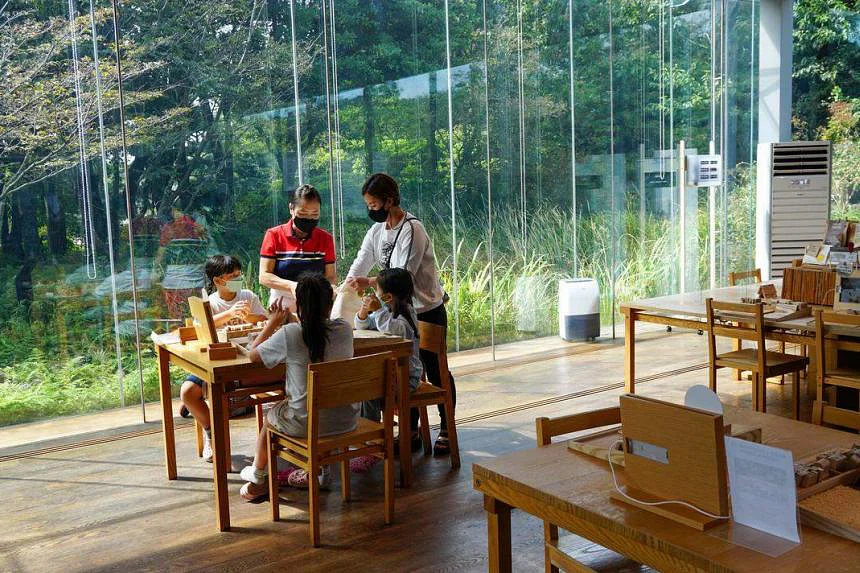
Make your own soap at Innisfree Jeju House. ST PHOTO: AILEEN TEO
Black pork is Jeju’s most famous dish, and you can try it at the Al Dong Ne Jib barbecue joint. (Romanised Hangul names may not show up in Google Maps so use this link – str.sg/wHCq) Pair the pork with a bowl of naengmyeon, or cold noodles (8,000 won), a refreshing contrast to the unctuous slabs of meat. A black pork set costs 20,000 won.
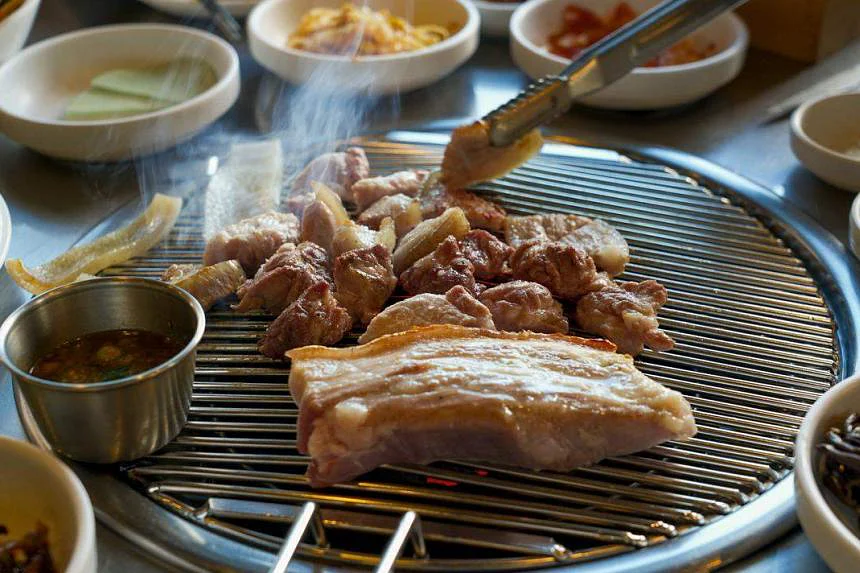
Black pork is probably Jeju’s most famous dish. ST PHOTO: AILEEN TEO
Jeju is divided into north and south by Mount Hallasan, a dormant volcano.
Drive south to Jeongbang Waterfall (2,000 won), the only falls in South Korea where water falls directly into the sea. You can clamber onto rocks to get up close. The island’s famed women divers, known as haenyo, who free-dive to harvest shellfish and seaweed, sometimes sell their catch from a makeshift shelter near the falls.

Jeongbang Waterfall is the only waterfall in South Korea where the water falls directly into the sea. ST PHOTO: AILEEN TEO
Nearby Cheonjiyeon Waterfall (2,000 won) requires less of a trek and is equally scenic. Each stop will take about 30 minutes.
Check in to Hotel Sumorum (sumorum.com; room rates start at about $120) before dark to catch a brilliant sunset from your room or the hotel pool, which overlooks the sea. And do not miss the heated pools, which the hotel calls a sauna. A soak in a warm jacuzzi is the perfect end to a day of walking.
Day three: Food trail
Put your pandemic baking skills to the test at Toto Atelier (str.sg/wHCc), a cooking school-cum-cafe where you can make savoury dishes and desserts.
Video tutorials bridge the language barrier, and staff are quick to swoop in should you run into any difficulty. I have baked my fair share of banana cakes and burnt cheesecake, but still found it useful to have someone tell me exactly when to stop whipping the meringue for my tangerine tart (27,000 won).

Journalist Clara Lock baking a tangerine meringue tart at Toto Atelier. ST PHOTO: AILEEN TEO
My tart turns out looking fancy, even if the thick crust tastes more like shortbread. A garnishing of apple mint, which I harvest fresh from their garden, is elegant in taste and appearance. But the best part is how I do not have to wash a single dirty dish after.

Tangerine meringue tart made by journalist Clara Lock at Toto Atelier. ST PHOTO: AILEEN TEO
Hairtail fish is a local speciality and is sold fresh at Dongmun Market during the autumn months, and frozen for consumption throughout the rest of the year. You will not miss the shiny ribbon-like fish gleaming under display lights.
You can also buy kimchi by the barrel, platters of sashimi-style raw fish known as hoe, and boxes of tangerines that the island is known for.

One of the many stalls selling hairtail fish (galchi) in Dongmun Market. ST PHOTO: AILEEN TEO
In the evening, there is a cooked food section with black pork rolls, fried stuffed squid and, the market’s most popular stall offering, lobster torched on a grill. Budget for about 8,000 to 12,000 won a dish.
Still hungry? Try hairtail fish at Hyeob Jae Seom Ba Da (str.sg/wHCN). The delicate flesh is sectioned and fried to a crisp: crunching on the fins is the best part. A set costs 10,900 won.
Stay at the Grand Hyatt Jeju, the island’s tallest building. Each of the hotel’s 1,600 rooms is at least 65 sq m, double the size of most entry-level hotel rooms, with a spacious living area and work space. Rates start at about $300.
My city view room overlooks Jeju Airport’s runway and I relish the view of planes landing every few minutes – unfathomable just a year ago, when travel had all but ground to a halt.
Day four: Flower parks and nature trails
Jeju has parks aplenty and a recent addition is Snoopy Garden (snoopygarden.com; admission: 18,000 won), which opened in 2020. Depicting the creation and evolution of the comic strip by cartoonist Charles M. Schulz, the exhibits are fun and informative.
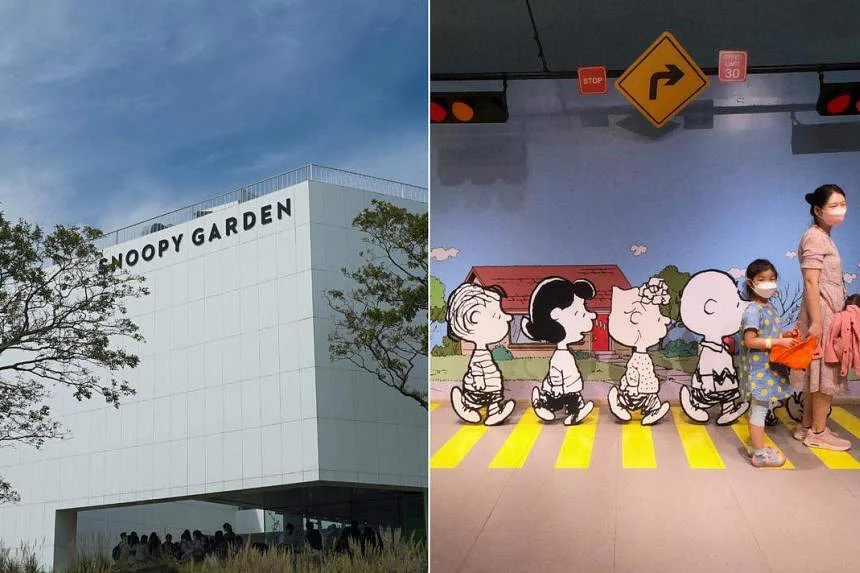
Snoopy Garden opened in 2020, with fun and informative exhibitions. ST PHOTOS: AILEEN TEO
As with many attractions, there are photo opportunities aplenty, most notably next to a giant Snoopy seated on a pier that South Korean boy band BTS member Jimin posed with for a photo. Join the queue of locals looking to recreate that shot.

There are photo opportunities aplenty at Snoopy Garden, most notably next to a giant Snoopy seated on a pier. ST PHOTO: AILEEN TEO
Try Jeju specialities sea urchin seaweed soup (12,000 won) and sea urchin bibimbap (22,000 won) at Ojomiya (str.sg/wHCR). Instead of the usual vegetable assortment, the bibimbap comes with seaweed of various textures and hues. Tossed with a heap of sea urchin, it is briny-fresh and delicious.

Sea urchin bibimbap comes with seaweed of various textures and hues. ST PHOTO: AILEEN TEO
A short drive away, take on the short but intense climb up Seongsan Ilchulbong, or Sunrise Peak (admission: 2,000 won). The effort-to-reward ratio is high – 20 to 30 minutes on a paved trail takes you to the top of the extinct volcano overlooking the sea on one side, and Jeju city on the other.

A 20- to 30-minute trek takes you to the summit of Seongsan Ilchulbong, or Sunrise Peak. ST PHOTOS: AILEEN TEO
Cool off at Arte Museum (artemuseum.com, admission: 17,000 won), housed in a former speaker factory and also opened in 2020.
Projections of iconic Jeju views – waterfalls, crashing waves and rapeseed flowers in bloom – adorn the space from floor to ceiling. The mirrored walls feel like a dreamscape or a maze I would not mind getting lost in. Judging by the number of people lolling on the floor, the immersive exhibition is the sort that will make you want to linger.
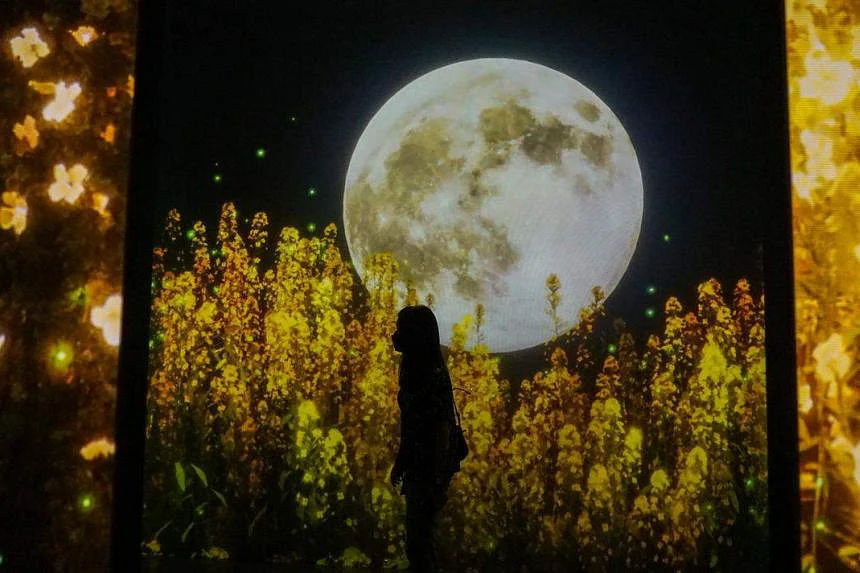
Arte Museum showcases an immersive media art exhibition in a former speaker factory. ST PHOTO: AILEEN TEO
Finish your day in downtown Jeju. Lotte Mart and Emart Sinjeju, both located in the city centre, have a good selection of snacks, makgeolli, Jeju craft beers and soju. Make room in your hand-carry luggage to take a bit of Jeju home.
Travel tips

Pink muhly grass at Hueree Nature Life Park. ST PHOTO: AILEEN TEO
Travellers to South Korea no longer need to provide a negative pre-departure Covid-19 test certificate.
Before your trip, apply for a Korea Electronic Travel Authorization (str.sg/wHCD) and upload your vaccination details (str.sg/wHCz).
Masks are required indoors.
Several car rental companies, such as Lotte Car Rental (str.sg/wHCK), operate in Jeju. My sports utility vehicle, which seats four comfortably and has ample space for luggage, costs about $212 a day.
Google Maps does not work well in South Korea, so download South Korean app Naver (str.sg/wHCr) for directions and to search for food.
The writer and video journalist Aileen Teo were hosted by Scoot and Jeju Tourism Organisation. This story was brought to you by Scoot.


